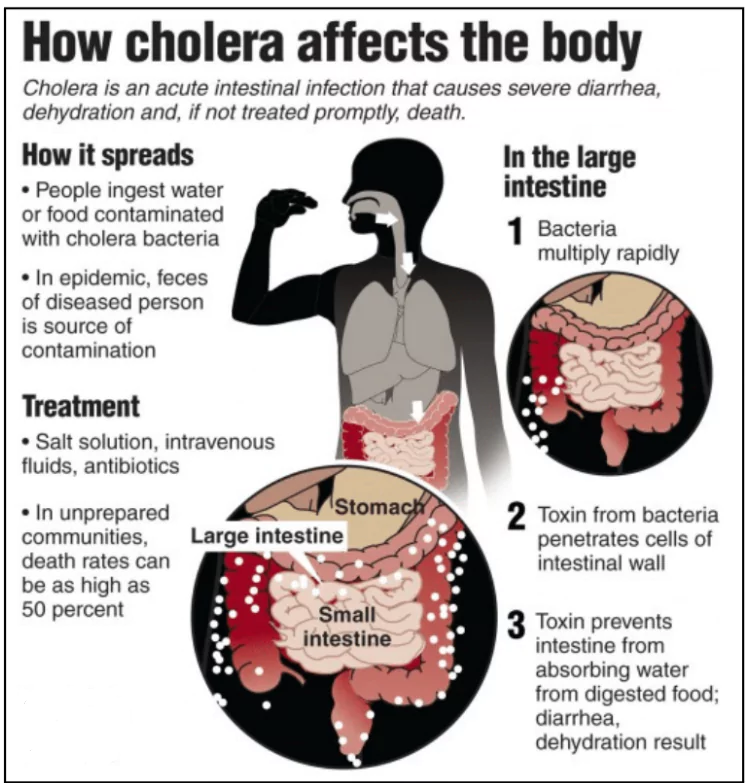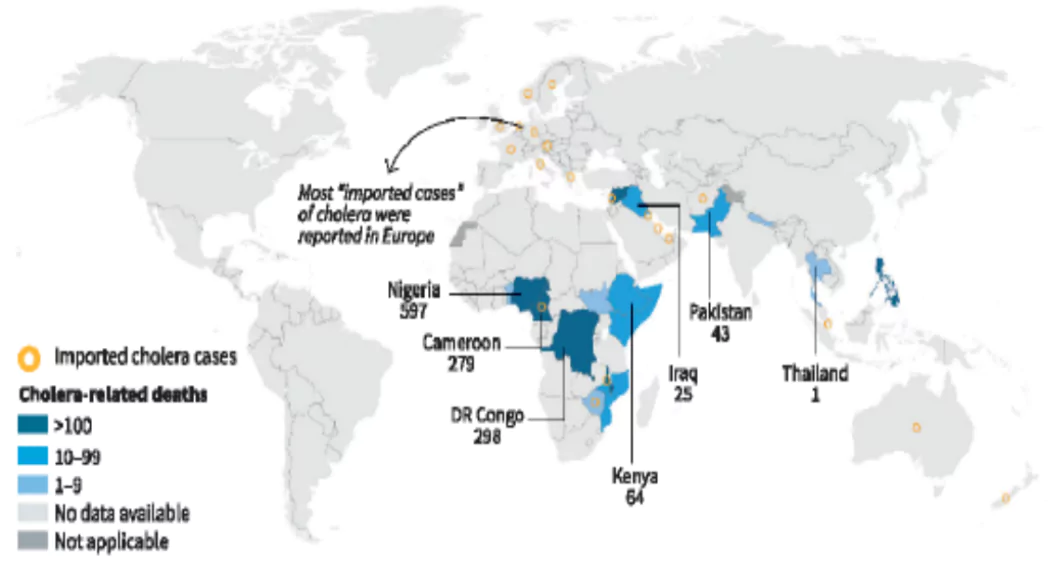The recent data released by the World Health Organization’s (WHO) has highlighted cholera as a preventable disease.

About Cholera
- Cholera is an acute diarrhoeal disease .
- It is caused by the bacterium Vibrio cholerae
- It is especially dangerous for people with low immunity, such as malnourished children and those with HIV/AIDS.
- Causes and Transmission: Cholera spreads through:
- Eating contaminated food.
- Drinking unsafe water.
- Contact with infected individuals (e.g., shaking hands).
- Seasonal Pattern: The disease peaks during hot, humid, and rainy seasons, especially during monsoons (June to September).
- Major contributing factors
- Climate Change: Warmer temperatures and changes in precipitation patterns can create favorable conditions for the spread of cholera.
 Conflict: Disasters and conflicts can disrupt water and sanitation infrastructure, making it difficult to prevent the spread of cholera.
Conflict: Disasters and conflicts can disrupt water and sanitation infrastructure, making it difficult to prevent the spread of cholera.- Lack of Access to Clean Water and Sanitation: Inadequate access to safe drinking water and sanitation facilities increases the risk of cholera transmission.
- Poverty and Displacement: Poverty and displacement can contribute to poor hygiene and sanitation practices.
- It makes populations more vulnerable to cholera.
Enroll now for UPSC Online Classes
India’s Efforts to tackle Cholera Disease
Cholera outbreaks are common in India. To tackle these issues, India has taken various steps.
- Total Sanitation Campaign: This campaign was implemented by the national rural health mission.
- It aims to improve sanitation, nutrition, and ensure availability of safe drinking water.
- Oral cholera vaccines (OCV): This vaccination drives are conducted in high risk zone to offer immunity during cholera seasons
- Village Health and Sanitation Committees: These committees are formed at the local level in which local leaders monitor and ensure availability of clean drinking water and toilets.
- Cholera hotspot mapping: India mapped cholera hotspots regions ( 2010 to 2015)to identify the areas of interventions.
- In mapping hotspots, GIS and disease surveillance data are used.
Global Cholera Situation
- UNICEF and WHO Data:
- 2 billion people lack access to safe drinking water.
- 3.6 billion people don’t have proper sanitation.
- Cholera deaths increased by 17% in 2023 compared to 2022, with 4,000 deaths reported last year.
- 22 countries are facing active cholera outbreaks in 2024.
- Geographical Distribution: Cholera cases have decreased in the Middle East and Asia but doubled in Africa.
- It highlights inequities in healthcare access.
- Global Initiatives
- Global task force for cholera control: It aims to end cholera by 2030 using multi sectoral interventions.
- Finding disease hotspots
- Improve sanitation and water infrastructure
|
Check Out UPSC NCERT Textbooks From PW Store
![]() 13 Sep 2024
13 Sep 2024

 Conflict: Disasters and conflicts can disrupt water and sanitation infrastructure, making it difficult to prevent the spread of cholera.
Conflict: Disasters and conflicts can disrupt water and sanitation infrastructure, making it difficult to prevent the spread of cholera.